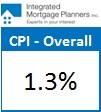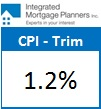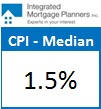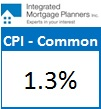Dave Larock in Interest Rate Update, Mortgages and Finances
Editor's Note: The Interest Rate Update appears weekly on this blog - check back every Monday morning for analysis that is always ahead of the pack.
Before they were anointed modern-day superheros who could stave off economic downturns with their mighty printing presses, inflate asset bubbles with their ultra-low policy rates and help financial markets leap over bad economic data in a single bound with only a few calming words, central bankers had a simple (and rather boring) mandate: to promote economic stability by using their monetary-policy tools to keep inflation under control.
It is important to remember the Bank of Canada’s (BoC) official mandate in the current context because while the Bank recently adopted a more hawkish stance around the timing of future rate hikes, it still cannot ignore our inflation levels when determining the correct policy-rate path forward.
While investors initially reacted to the BoC’s more hawkish language by bidding up both Government of Canada (GoC) bond yields and the Loonie in anticipation of higher of rates to come, Statistic Canada’s release of our latest inflation data last week, for May, gives us the real proof in the Bank’s rhetorical pudding.
To measure our rate of inflation, the BoC now uses four different Consumer Price Index (CPI) gauges, and its stated goal is to keep each of them within a range of 1% to 3%, and ideally, trending toward its official target rate of 2%.
Perhaps somewhat disappointingly for the BoC, the latest inflation data continue to show benign, gradual price growth that isn’t calling for monetary-policy tightening any time soon. If the BoC were to raise rates against our current backdrop of low inflation, there is a risk that prices might stop rising altogether, and possibly even fall instead (and that phenomenon, known as deflation, is what really keeps central bankers up at night).
Let’s look at the May CPI data and briefly revisit what each of the BoC’s CPI inflation gauges is designed to measure:
Overall CPI rose by 1.3% in May (on a year-over-year basis). That result was lower than the consensus forecast of 1.5% for the month, and was down from 1.6% in April. Overall CPI has fallen steadily throughout 2017 after starting the year at 2.1% and, most interestingly, core inflation, which strips out more volatile CPI inputs like food and energy, came in at only 0.9% in May, marking its lowest level since 1999.
CPI Trim is defined as “a measure of core inflation that excludes CPI components whose rates of change in a given month are located in the tails of the distribution of price changes”. In other words, if a specific component of the CPI moves dramatically in a given month, that spike is treated as a one-off and the affected item is excluded from the CPI-trim measure. So, for example, if the price of vegetables goes through the roof, CPI-trim will ensure that it doesn’t lead us to misinterpretations about a broader change in underlying inflation. CPI Trim fell to 1.3% last month and has been falling steadily over the past year from its most recent peak of 2.0% in June, 2016.
CPI Median is defined as “a measure of core inflation corresponding to the price change located at the 50th percentile (in terms of CPI basket weights) of the distribution of price changes in a given month”. Put more simply, the CPI tracks changes in the price of a wide variety of items, and some move up or down more than others. CPI-median filters out item-specific volatility, as CPI-trim does, but in a different way. CPI-median plots the monthly percentage change in the price of each CPI item on a scale, and focuses on the price change of the item at the mid-point of that scale as the CPI- median. To put this in a practical context, if the prices of a few items spike dramatically in a month when the price of most items remains relatively stable, overall CPI would move higher while CPI-median will capture the change in the price of the item at the mid-point of its scale, thereby eliminating the distorting impact of the more volatile elements. (Here is a short video from the Cleveland Fed that describes how CPI Median works in more detail.) CPI Median fell to 1.5% last month and has been falling steadily over the past year from its most recent peak of 2.2% in June, 2016.
CPI Common is defined as “a measure of core inflation that tracks common price changes across categories in the CPI basket”. Of the three relatively new gauges, this one is the most complicated to explain. In essence, it tries to isolate the changes in price movements that are related to overall changes in aggregate demand, rather than to sector-specific changes. CPI Common stayed flat at 1.3% last month and has been falling since it last peaked at 1.7% in May, 2016.
In summary, all four of the BoC’s key inflation gauges are hovering at the low end of the BoC’s 1% to 3% target range and remain well below the Bank’s 2% target. Bluntly put, our current inflationary backdrop implies that the Bank should be cutting its policy rate, not raising it, and that’s especially true when viewing inflation through a broader lens.
Overall U.S. inflation peaked at 2.7% in February of this year but has since fallen steadily back to 1.9%, and, with U.S. prices still declining in most areas, that trend shows no sign of abating. (U.S. core inflation also slowed to 1.7% in May, marking a two-year low for that measure.) Our two economies are tightly linked so we tend to import U.S. inflation rates over time, and as such, if U.S. inflation rates continue to fall, it is even more likely that Canadian inflation rates will remain benign.
The BoC will rightly argue that several key components of inflation, such as the cost of labour, are lagging indicators, which means they won’t start to rise until overall inflation has already begun to accelerate. The Bank worries that if it waits too long to start raising its policy rate, it may have to increase it more rapidly to keep inflation under control, and doing that could cause economic disruptions.
Deputy BoC Governor Carolyn Wilkens recently alluded to this when she said that “If you saw a stop light ahead, you would begin letting up on the gas to slow down smoothly … You don’t want to have to slam on the brakes at the last second. Monetary policy must also anticipate the road ahead.” But if the inflation data represent the stop light in her analogy, then that light is still flashing bright green.
Five-year GoC bond yields fell two basis points last week, closing at 1.12% on Friday. Five-year fixed-rate mortgages are available at rates as low as 2.29% for high-ratio buyers, and at rates as low as 2.39% for low-ratio buyers, depending on the size of their down payment and the purchase price of the property. Meanwhile, borrowers who are looking to refinance should be able to find five-year fixed rates in the 2.59% to 2.69% range.
Five-year variable-rate mortgages are available at rates as low as prime minus 0.80% (1.90% today) for high-ratio buyers, and at rates as low as prime minus 0.70% (2.00% today) for low-ratio buyers, again depending on the size of their down payment and the purchase price of the property. Borrowers who are looking to refinance should be able to find five-year variable rates around the prime minus 0.40% to 0.45% range, which works out to between 2.20% and 2.25% using today’s prime rate of 2.70%.
The Bottom Line: When the BoC recently adopted more hawkish policy-rate language and GoC bond yields spiked in response, I advised variable-rate borrowers not to panic. Our latest inflation data lend further support to that advice and imply that the BoC’s actions aren’t likely to match its words for some time yet. If I’m right, both our fixed and variable rates should remain at or near their current levels, and any short-term run-up in our fixed-mortgage rates should be short lived.
David Larock is an independent mortgage broker and industry insider specializing in helping clients purchase, refinance or renew their mortgages. David's posts appear weekly on this blog, Move Smartly, and on his own blog: integratedmortgageplanners.com/blog Email Dave
June 26, 2017
Mortgage |







